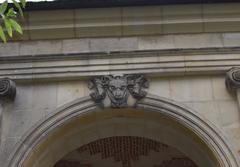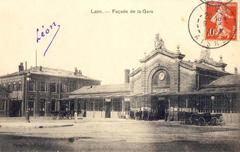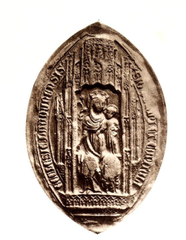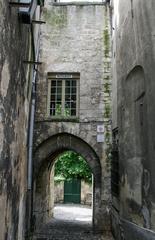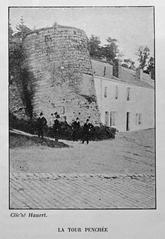
Abbey of St. Martin Laon, France: Visiting Hours, Tickets, and Historical Sites Guide
Date: 04/07/2025
Introduction
Nestled within the historic city of Laon in northern France, the Abbey of St. Martin stands as a testament to centuries of spiritual devotion, architectural innovation, and cultural significance. Founded in 1124 by Barthélemy of Jur, bishop of Laon, alongside Saint Norbert of Xanten—the founder of the Premonstratensian Order—the abbey quickly rose to prominence as one of the earliest and most influential Norbertine houses (Wikipedia; Spotting History).
The Abbey’s architectural journey, marked by a transition from Romanesque solidity to early Gothic elegance, mirrors the evolution found in the nearby Laon Cathedral (France Travel Planner; France This Way). Today, the abbey is not only a place of worship and tranquility but also a vibrant cultural venue and historical landmark. This guide provides comprehensive details about the abbey’s history, architectural highlights, visiting hours, ticketing, accessibility, and nearby attractions—ensuring you make the most of your visit to Laon’s medieval heart. For additional resources, consult the Laon tourism website and the Abbey’s official site.
Table of Contents
- Historical Overview
- Religious and Cultural Importance
- Key Transformations
- Visiting Information
- FAQs
- Summary and Visitor Tips
- References
Historical Overview
Foundation and Early Development
The Abbey of St. Martin was founded in 1124, at a time of significant monastic reform in Europe. Barthélemy of Jur invited Saint Norbert of Xanten to establish a Premonstratensian community on the site of a former Carolingian collegiate church (France-Voyage). The initial community, composed of twelve canons from Prémontré Abbey, symbolized the apostolic tradition and quickly established St. Martin as a leading Norbertine house (Saint-Martin de Tours).
Architectural Evolution
Romanesque and Gothic Phases
Construction began around 1160, with the choir and transepts completed by 1190 (France-Voyage). The abbey’s architecture reveals a transition from the heavy, rounded forms of Romanesque to the lightness and verticality of Gothic style. The 13th century saw further Gothic enhancements, including the addition of towers and a new western façade from 1270. Although the original spires were removed in 1605, the structure remains a harmonious blend of both architectural traditions (Blog Alan Dotchin).
Later Modifications
Baroque influences arrived in the 17th and 18th centuries, with the construction of a new abbey palace, formal gardens, and reconstructed cloister (Saint-Martin de Tours). Despite damage in 1944, core features such as the church and cloister have been preserved (France-Voyage).
Religious and Cultural Importance
Spiritual and Pilgrimage Center
From its inception, the abbey served as a spiritual hub and a major pilgrimage destination, especially after acquiring the left arm relic of Saint Lawrence in 1230 (Wikipedia; France-Voyage). Fairs and festivals associated with the abbey enriched Laon’s religious and civic life.
Medieval Learning and Art
The Abbey’s scriptorium and library were widely recognized, and its church houses significant artistic treasures, including 18th-century woodwork, medieval effigies, and a rediscovered 14th-century nativity scene (Blog Alan Dotchin; France-Voyage).
Key Transformations
- Medieval Prosperity: The abbey flourished but endured challenges from war and political shifts.
- French Revolution: The religious community was disbanded, property nationalized, and the church repurposed as a parish and later a hospital (Wikipedia).
- Modern Times: The church was classified as a Historic Monument in 1862. Today, the cloister grants access to the city library, and restoration efforts have preserved much of the complex (Saint-Martin de Tours).
Visiting Information
Opening Hours
- Main Nave and Gardens: Generally open daily from 9:00 AM to 6:00 PM; hours may vary seasonally or during special events. Always check the official Laon tourism website or parish site prior to your visit.
- Tower Access: Available during summer afternoons and special events; check schedules in advance.
Tickets and Admission
- General Entry: Free for the main nave and gardens.
- Tower Climb & Special Exhibitions: Tickets required; approx. €5 for adults, €3 for seniors and students, free for children under 12. Buy on-site or online (Abbey’s official site).
Accessibility
- The nave and gardens are wheelchair accessible. The tower is only accessible via stairs.
- Some historic areas have limited access for those with reduced mobility; contact the abbey in advance for assistance.
Guided Tours and Special Events
- Guided tours, available in multiple languages, provide in-depth commentary on the abbey’s history and architecture. Audioguides are also offered.
- The abbey hosts religious services, concerts (notably during the summer), and art exhibitions. These events enrich the visitor experience—consult the event calendar.
Facilities
- Public restrooms and benches in the gardens.
- The abbey complex houses the municipal library and a hospital.
- Numerous cafes and restaurants nearby in Laon’s historic center.
Nearby Attractions
- Laon Cathedral: A masterpiece of early Gothic architecture.
- Medieval Ramparts: Walks along the ancient city walls offer panoramic views.
- Belfry, Citadel, and Musée d’Art et d’Archéologie: Additional insights into Laon’s rich past.
- Medicinal Garden and Orchard: Echoing the abbey’s monastic traditions (The Crazy Tourist).
Photography Tips
- Best light: Early morning or late afternoon for the façade and gardens.
- The tower offers prime vantage points for city panoramas.
- Respect photography policies inside the church and during services.
Frequently Asked Questions (FAQ)
Q: What are the Abbey’s visiting hours?
A: 9:00 AM to 6:00 PM; confirm seasonal variations online.
Q: Is there an admission fee?
A: General entry is free; tickets required for tower climbs and special exhibits.
Q: Are guided tours available?
A: Yes, often in multiple languages—book in advance during peak periods.
Q: Is the abbey accessible?
A: The nave and gardens are accessible; the tower is not suitable for wheelchairs.
Q: What else is there to see nearby?
A: Laon Cathedral, city ramparts, museum, and more.
Summary of Key Points and Visitor Tips
The Abbey of St. Martin is a must-see for lovers of medieval history, architecture, and tranquil gardens. Free general admission, accessible guided tours, and its location amidst Laon’s other historical highlights make it an essential stop. Plan ahead by checking opening hours, booking tickets for tower climbs and tours, and exploring the surrounding city for a comprehensive cultural experience (Tourisme Pays de Laon; Laon Tourist Office).
Visual Resources
Alt tags include keywords such as ‘Abbey of St. Martin Laon visiting hours’, ‘Abbey of St. Martin Laon tickets’, and ‘Laon historical sites’ for SEO optimization.
Plan Your Visit and Stay Connected
Stay updated on opening hours, tickets, and events by visiting the Abbey’s official website and the Laon tourism website. For travel tips, itinerary suggestions, and real-time updates, download the Audiala app.
References and Further Reading
- Abbey of Saint Martin de Laon, Wikipedia
- Abbey of St. Martin Laon: Visitor’s Guide, Spotting History
- Abbey of St. Martin Laon, France-Voyage
- Ensemble Abbatial Saint Martin, Saint-Martin de Tours
- France Travel Planner: Laon
- Laon, France This Way
- The Crazy Tourist: Best Things in Laon
- Tourist Places Guide: Laon Travel Guide
- Visiting the Abbey: Laon Tourist Office
- Audiala app











